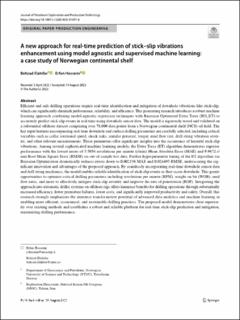| dc.description.abstract | Efficient and safe drilling operations require real-time identification and mitigation of downhole vibrations like stick-slip, which can significantly diminish performance, reliability, and efficiency. This pioneering research introduces a robust machine learning approach combining model-agnostic regression techniques with Bayesian Optimized Extra Trees (BO_ET) to accurately predict stick-slip events in real-time using downhole sensor data. The model is rigorously tested and validated on a substantial offshore dataset comprising over 78,000 data points from a Norwegian continental shelf (NCS) oil field. The key input features encompassing real-time downhole and surface drilling parameters are carefully selected, including critical variables such as collar rotational speed, shock risks, annular pressure, torque, mud flow rate, drill string vibration severity, and other relevant measurements. These parameters offer significant insights into the occurrence of harmful stick-slip vibrations. Among several sophisticated machine learning models, the Extra Trees (ET) algorithm demonstrates superior performance with the lowest errors of 5.5056 revolutions per minute (r/min) Mean Absolute Error (MAE) and 9.9672 r/min Root Mean Square Error (RMSE) on out-of-sample test data. Further hyperparameter tuning of the ET algorithm via Bayesian Optimization dramatically reduces errors down to 0.002156 MAE and 0.024495 RMSE, underscoring the significant innovation and advantages of the proposed approach. By seamlessly incorporating real-time downhole sensor data and drill string mechanics, the model enables reliable identification of stick-slip events as they occur downhole. This grants opportunities to optimize critical drilling parameters including revolutions per minute (RPM), weight-on-bit (WOB), mud flow rates, and more to effectively mitigate stick-slip severity and improve the rate of penetration (ROP). Integrating the approach into automatic driller systems on offshore rigs offers immense benefits for drilling operations through substantially increased efficiency, fewer premature failures, lower costs, and significantly improved productivity and safety. Overall, this research strongly emphasizes the immense transformative potential of advanced data analytics and machine learning in enabling more efficient, economical, and sustainable drilling practices. The proposed model demonstrates clear superiority over existing methods and establishes a robust and reliable platform for real-time stick-slip prediction and mitigation, maximizing drilling performance. | en_US |

